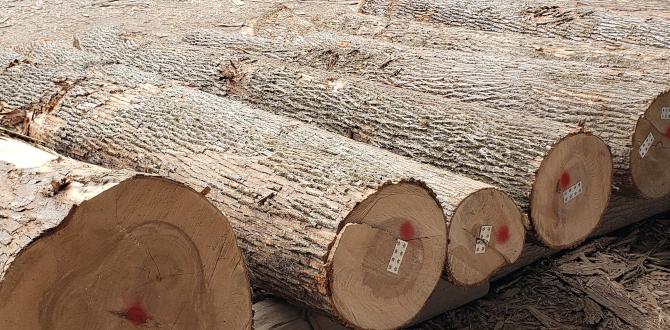Choose the right air compressor for your air nailer by matching its CFM and PSI requirements to the compressor’s output. Consider portability, tank size, and noise level for your specific projects and workspace.
Hey there, fellow DIYer! So, you’ve got a shiny new air nailer, ready to tackle that trim work, deck project, or even a birdhouse. That’s fantastic! But wait – there’s a crucial piece missing: the air compressor. It’s the heart that pumps life into your nailer, and picking the wrong one can lead to weak nails, frustrating jams, or a compressor that’s way too big and loud for your garage. Don’t worry, I’ve been there! This guide is all about making that choice simple, so you can get back to building.
We’ll break down exactly what you need to know, from confusing specs like CFM and PSI to the practical stuff like how much air you actually need. By the end of this, you’ll feel confident choosing the best compressor that’ll make your air nailer sing.
Table of Contents
What is an Air Compressor and Why Does Your Nailer Need One?
Think of an air compressor as a powerful gadget that takes regular air from your surroundings and squeezes it into a tank, building up pressure. This pressurized air is then delivered to your air nailer through a hose. When you pull the trigger on your nailer, it releases a blast of this stored air, which drives the nail into your material. Without enough pressurized air, your nailer just won’t have that “oomph” to do its job effectively. It’s like trying to blow up a balloon with a tiny puff of air – it just won’t get very far!
Understanding the Key Specs: CFM and PSI
These two acronyms, CFM and PSI, are your best friends when it comes to matching a compressor to your nailer. Let’s break them down so they’re as clear as a perfectly driven nail.
CFM: Cubic Feet per Minute
CFM tells you how much air volume the compressor can deliver per minute. This is super important because your nailer needs a consistent flow of air to operate. Different nailers use air at different rates. A small brad nailer that fires tiny nails uses much less air than a framing nailer that drives big, chunky nails. When you’re choosing a compressor, you need to find one that puts out at least as much CFM as your nailer requires, often with a little extra to spare.
Why is a little extra CFM good? If your compressor is just barely meeting your nailer’s demand, it will constantly be running to keep up. That can overheat the motor and wear it out faster. Having a bit of headroom means the compressor doesn’t have to work as hard, leading to a longer life and more consistent performance.
PSI: Pounds per Square Inch
PSI refers to the air pressure. It’s how much force the air is pushing with. Most air nailers operate within a specific pressure range, usually between 70 and 120 PSI. You’ll find this information on your nailer itself or in its manual. Your compressor needs to be able to reach and maintain the necessary PSI for your nailer to function correctly.
Most compressors can produce PSI well above what nailers need, so PSI is usually less of a limiting factor than CFM. However, it’s still crucial to check that your chosen compressor can indeed provide the required PSI. If the PSI is too low, your nailer won’t drive nails fully, leaving them sticking out awkwardly. If it’s too high, you risk damaging the nailer or your workpiece, though most compressors have adjustable regulators to set the exact PSI you need.
Different Types of Air Compressors
When you start looking, you’ll see a few main types of compressors. For most DIYers and woodworking hobbyists using air nailers, you’ll be looking at two main categories:
Pancake Compressors
As the name suggests, these are flat and wide, resembling a pancake. They are very popular for home use because they are:
- Compact: Easy to store and move around.
- Lightweight: Much easier to carry to job sites or around your house.
- Affordable: Generally less expensive than other types.
- Good for light-duty tasks: Perfect for trim nailers, brad nailers, staplers, and inflation.
However, pancake compressors typically have smaller tanks and may not be able to keep up with tools that demand a lot of air, like framing nailers, if you’re nailing continuously. They can also be a bit noisy.
Hot Dog Compressors
These are taller and narrower than pancake compressors, looking a bit like a hot dog bun. They offer a good balance:
- More Airflow: Often provide higher CFM than pancake models.
- Larger Tanks: Hold more compressed air, allowing for longer run times before the motor kicks in.
- Versatile: Can handle a wider range of nailers, including some framing nailers and roofing nailers for intermittent use.
- Still Relatively Portable: Easier to move than larger stationary units.
They can be a bit more expensive and take up a different kind of space than pancake models.
Wheelbarrow Compressors
These are larger, more powerful units, often with bigger engines (sometimes gas-powered) and larger tanks. You’ll find them on wheels, making them easier to move around a large workshop or construction site.
- High Airflow: Excellent CFM output for demanding tools.
- Designed for Heavy Use: Can power multiple nailers or larger tools simultaneously.
- Ideal for Professionals: Often overkill for basic DIY projects but great for serious woodworkers or job sites.
The main downsides are their size, weight, cost, and noise level. They are not typically what a beginner would need for just a nailer or two.
Stationary Compressors
These are the big boys, usually bolted down in a workshop. They have the largest tanks and can deliver the most air. They are designed for continuous, heavy-duty use and are usually much quieter than portable units.
- Maximum Air Output: Unmatched CFM and ability to run multiple tools.
- Continuous Operation: Built for long, uninterrupted work sessions.
- Quieter Operation: Significantly less noise than portable models.
These are generally for dedicated workshops and advanced woodworkers. For most DIY homeowners and hobbyists using air nailers, a portable pancake or hot dog style compressor is the way to go.
How to Calculate Your CFM Needs
This is where we get down to brass tacks. To choose the right compressor, you need to know how much air your nailer uses. The good news is, it’s usually pretty straightforward!
Finding Your Nailer’s CFM Requirement
Look for a label directly on your air nailer, in its instruction manual, or on the manufacturer’s website. It will typically state the required CFM at a specific PSI (e.g., 2.0 CFM @ 90 PSI). This is the minimum CFM your compressor needs to supply.
The Rule of Thumb for Compressor Sizing
It’s generally recommended to choose a compressor that provides about 1.5 to 2 times the CFM that your tool (or tools) requires. This buffer ensures smooth operation and prevents the compressor from being overworked.
Example:
- If your brad nailer requires 1.0 CFM @ 90 PSI, you should look for a compressor that can deliver at least 1.5 to 2.0 CFM @ 90 PSI.
- If your framing nailer requires 2.5 CFM @ 90 PSI, aim for a compressor that provides 3.75 to 5.0 CFM @ 90 PSI.
Using this multiplier is key to a happy tool and compressor relationship. More air than your tool needs is always better than not enough. For a great resource on understanding CFM and tool requirements, check out this guide from Fine Homebuilding.
Tank Size: Does It Matter?
The tank size, measured in gallons, is another important factor. The tank acts as a reservoir for compressed air. A larger tank means:
- More stored air available at your nailer.
- The compressor motor runs less frequently.
- A smoother, more consistent air supply, especially for tools that use air in bursts or for longer periods.
Here’s a breakdown:
- Small Nailers (Brad, Finish): A compressor with a 2-6 gallon tank is usually sufficient. You might only need to tap into the reservoir occasionally.
- Medium Nailers (Framing, Roofing): Consider a tank size of 10-20 gallons. This will give you a good buffer for driving multiple nails in quick succession without waiting for the compressor to recharge.
- Continuous Use / Multiple Tools: If you’re doing a lot of nailing or planning to use other air tools alongside your nailer, a larger tank (20+ gallons) is beneficial.
While CFM is king for powering a tool, a larger tank helps maintain that power for longer stretches, especially if your CFM output is borderline for a specific task. It’s a balance – you don’t necessarily need a giant tank if your CFM is high enough to meet demand, but it certainly helps!
Portable vs. Stationary Compressors for DIY
For most of us tackling projects around the house, portability is a major advantage. You might need to bring your compressor from the garage to the backyard, or up to the second floor. This is where pancake and hot dog compressors shine.
Portable Compressors:
- Pros: Easy to move, take up less space, more affordable for basic needs.
- Cons: Can be noisier, may not have the CFM or tank size for heavy-duty jobs.
Stationary Compressors:
- Pros: High power, large capacity, quieter, designed for long-term use.
- Cons: Not portable, expensive, require dedicated space and power.
Unless you have a dedicated workshop and plan to do extensive woodworking, a portable compressor is almost always the best choice for air nailing projects around the home.
Noise Levels: Consider Your Neighbors (and Your Sanity!)
Air compressors can be LOUD. This is especially true for smaller, portable units that have to work harder to maintain pressure. Some can reach 80-100 decibels or more – that’s comparable to a lawnmower or a motorcycle!
If you’re working in a dense neighborhood, have close living quarters, or are sensitive to noise, look for compressors advertised as “quiet” or “low noise.” These models often use different motor designs or insulation to reduce sound output. While they might cost a bit more, the peace and quiet (for you and your neighbors) are often worth it. Some manufacturers even rate their noise levels in decibels (dB), so you can compare them directly.
Oil-Lubricated vs. Oil-Free Compressors
This is another distinction you’ll see. The type of compressor motor affects maintenance and the quality of the air it produces.
Oil-Free Compressors
These are very common in portable and home-use models. Their pistons are designed to run without oil, meaning:
- Low Maintenance: No oil changes or checking oil levels.
- Lighter Weight: Generally less heavy than their oil-lubed counterparts.
- Cleaner Air (Potentially): No risk of oil contamination in the air lines. This is great for painting or if you’re working with materials where oil residue would be a problem.
- Can be Noisier: The lack of lubrication can sometimes lead to more mechanical noise.
- Shorter Lifespan (Potentially): The internal components might wear out faster without lubrication, though modern designs are very durable.
Oil-Lubricated Compressors
These use a small amount of oil to lubricate the pistons and cylinders. This leads to:
- Quieter Operation: The oil acts as a dampener.
- Longer Lifespan: Lubrication reduces wear and tear, extending the compressor’s life.
- More Durable: Often built for heavier use.
- Higher Maintenance: Require regular oil checks and changes.
- Risk of Oil in Air Line: You may need an oil-water separator if you’re doing delicate work like painting.
For most nailer applications, an oil-free compressor is perfectly adequate and offers the best convenience. If you anticipate very heavy, continuous use or want the absolute longest lifespan, an oil-lubricated model might be worth considering, but be prepared for extra maintenance.
Matching Your Nailer Type to Compressor Needs
Let’s get specific. Different types of nailers have different appetites for air. Knowing your nailer type is your first step to knowing your compressor requirements.
Brad Nailers and Finish Nailers
These are the workhorses for trim, molding, and light cabinetry. They fire slim nails and don’t demand a ton of air.
- Typical CFM: 0.5 – 1.5 CFM @ 90 PSI
- Recommended Compressor: A small pancake compressor with a tank of 2-6 gallons is often sufficient. Look for a compressor that outputs at least 1.5-2.0 CFM @ 90 PSI.
Framing Nailers
Used for building walls, decks, and other structural components, these fire large nails and need a significant burst of air.
- Typical CFM: 2.0 – 3.5 CFM @ 90 PSI
- Recommended Compressor: You’ll need a more robust compressor. A hot dog style or larger pancake compressor with a tank of at least 6-10 gallons is a good start. Aim for a compressor with 3.5-5.0 CFM @ 90 PSI. Continuous nailing might even push you towards a 20-gallon tank.
Roofing Nailers
These are designed for quick firing of nails into roofing shingles. They use a good amount of air because they need to drive nails effectively even through tough materials.
- Typical CFM: 2.0 – 3.0 CFM @ 90 PSI
- Recommended Compressor: Similar to framing nailers. A hot dog compressor with a 10-20 gallon tank and an output of at least 4.0-5.0 CFM @ 90 PSI is advisable.
Pin Nailers and Micro Pin Nailers
These are for the smallest, most delicate work and use tiny headless pins. They require very little air.
- Typical CFM: 0.1 – 0.5 CFM @ 90 PSI
- Recommended Compressor: Even the smallest pancake compressors will easily handle these. You likely won’t stress any compressor with just a pin nailer.
It’s always wise to check the specific requirements of the nailer you own or plan to purchase.




